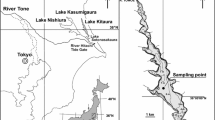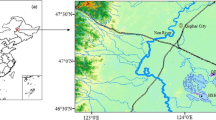Abstract
Lake Pamvotis is a shallow Mediterranean lake located in northwestern Greece that has been recognized as an internationally important conservation site. Here, an unprecedented investigation was undertaken to obtain and evaluate data related to sedimentary organic matter, hydrocarbon content, and stable isotopes of Lake Pamvotis sediments, thus tracking the origin of organic inputs and providing a record of environmental status. The study revealed a distinct spatial distribution of polycyclic aromatic hydrocarbons (PAHs) with values between 34.7 and 1600 μg/kg and a rather uniform pattern for n-alkanes with concentrations falling below 41.4 μg/g. A significant contribution of an unresolved complex mixture indicated anthropogenic petroleum contamination. Further study of relevant indexes and geochemical biomarkers supported a mixed-source input of aliphatic hydrocarbons. With regard to PAHs, there was strong evidence that their dominant origin is pyrogenic. Finally, considerable excursion in δ13Corg was attributed to changes in dissolved inorganic carbon accompanied by increased input of effluents and recycling of organic carbon within the lake, whereas the rise in isotopic composition of nitrogen was associated with agricultural runoff and sewage input from the town of Ioannina.




Similar content being viewed by others
References
Blummer M, Sass J (1972) Indigenous and petroleum-derived hydrocarbons in a polluted sediment. Marine Pollut Bull 3:92–94. doi:10.1016/0025-326X(72)90180-4
Bourbonniere RA, Meyers PA (1996) Anthropogenic influences on hydrocarbon contents of sediments deposited in eastern Lake Ontario since 1800. Environ Geol 28:22–28. doi:10.1007/s002540050074
Colombo JC, Cappelleti N, Lasci J, Migoya MC, Speranza E, Skorupka CN (2005) Sources, vertical fluxes, and accumulation of aliphatic hydrocarbons in coastal sediments of the Rio de la Plata Estuary, Argentina. Environ Sci Technol 39:8227–8234. doi:10.1021/es051205g
Cranwell PA, Eglinton G, Robinson N (1987) Lipids of aquatic organisms as potential contributors to lacustrine sediments. Org Geochem 11:513–527
Deines P (1980) The isotopic composition of reduced organic carbon. In: Fritz P, Fontes JCh (eds) Handbook of environmental isotope geochemistry, vol 1: the terrestrial environment. Part A. Elsevier, Amsterdam, pp 329–406
Farrington JW, Tripp BW (1977) Hydrocarbons in western North Atlantic surface sediments. Geochim Cosmochim Acta 41:1627–1641. doi:10.1016/0016-7037(77)90173-9
Fernández P, Vilanova RM, Grimalt JO (1999) Sediment fluxes of polycyclic aromatic hydrocarbons in European high altitude mountain lakes. Environ Sci Technol 33:3716–3722. doi:10.1021/es9904639
Ficken KJ, Li B, Swain DL, Eglinton G (2000) An n-alkane proxy for the sedimentary input of submerged/floating freshwater aquatic macrophytes. Org Geochem 31:745–749
Frysinger GS, Gaines RB, Xu L, Reddy CM (2003) Resolving the unresolved complex mixture in petroleum-contaminated sediments. Environ Sci Technol 37:1653–1662. doi:10.1021/es020742n
Gough MA, Rowland SJ (1990) Characterization of unresolved complex mixtures of hydrocarbons in petroleum. Nature 344:648–650. doi:10.1038/344648a0
Grimalt J, Albaiges J (1987) Sources and occurrence of C12 – C22 n-alkane distributions with even carbon-number preference in sedimentary environments. Geochim Cosmochim Acta 51:1379–1384
Gschwend PM, Hites RA (1981) Fluxes of polycyclic aromatic hydrocarbons to marine and lacustrine sediments in the northeastern United States. Geochim Cosmochim Acta 45:2359–2367. doi:10.1016/0016-7037(81)90089-2
Harvey RG (1997) Polycyclic aromatic hydrocarbons, 1st edn. Wiley-VCH, New York
Hedges JI, Stern JH (1984) Carbon and nitrogen determination of carbonate- containing solids. Limnol Oceanogr 29:657–663
Herczeg AL, Smith AK, Dighton JC (2001) A 120 year record of changes in nitrogen and carbon cycling in Lake Alexsandrina, South Australia: C:N, δ15 N and δ13C in sediments. Appl Geochem 16:73–84. doi:10.1016/S0883-2927(00)00016-0
Higgs ES, Vita-Finzi C, Harris DR, Fagg AE (1967) The climate, environment and industries of Stone Age Greece: Part III. Proc Prehistoric Soc 33:1–29
Hollander DJ, Smith MA (2001) Microbially mediated carbon cycling as a control on the δ13C of sedimentary carbon in eutrophic Lake Mendota (USA): new models for interpreting isotopic excursions in the sedimentary record. Geochim Cosmochim Acta 65:4321–4337. doi:10.1016/S0016-7037(00)00506-8
Howsam M, Jones KC (1998) Sources of PAHs in the environment. In: Neilson AH (ed) The handbook of environmental chemistry, vol 3.1: PAHs and related compounds–chemistry. Springer, Berlin, pp 137–174
IARC, WHO (1983) IARC monographs, polynuclear aromatic compounds, Part 1, Chemical, environmental and experimental data, Lyons, France, vol 32
Jones DM, Rowland SJ, Douglas AG, Howells S (1986) An examination of the fate of Nigerian crude-oil in surface sediments of the Humber estuary by gas-chromatography and gas-chromatography-mass spectrometry. Int J Environ Anal Chem 24:227–247. doi:10.1080/03067318608076473
Kagalou I, Economidis G, Leonardos I, Papaloukas C (2006b) Assessment of a Mediterranean shallow lentic ecosystem (Lake Pamvotis, Greece) using benthic community diversity: response to environmental parameters. Limnologica 36:269–278. doi:10.1016/j.limno.2006.08.002
Kagalou I, Leonardos l (2006a) Planktonic respiration in a shallow eutrophic Lake. J Freshwater Ecol 21:531–533
Kagalou I, Papastergiou E, Leonardos I (2008) Long term changes in the eutrophication process in a shallow Mediterranean lake ecosystem of W. Greece: response after the reduction of external load. J Environ Manag 87:497–506. doi:10.1016/j.jenvman.2007.01.039
Kagalou I, Papastergiadou E, Tsimarakis G, Petridis D (2003) Evaluation of the trophic state of Lake Pamvotis Greece, a shallow urban lake. Hydrobiologia 506:745–752
Kagalou I, Tsimarakis G, Patsias A (2001) Phytoplankton dynamics and physical-chemical features of a shallow lake (L.Pamvotis, Greece). Fresenius Environ Bull 10:845–849
Kaplan IR, Lu S-T, Alimi HM, McMurphey J (2001) Fingerprinting of high boiling hydrocarbon fuels, asphalts and lubricants. Environ Forens 2:231–248. doi:10.1006/enfo.2001.0053
Kennish MJ (1997) Polycyclic aromatic hydrocarbons. In: Kennish MJ (ed) Practical handbook of estuarine marine pollution. CRC Press, Boca Raton, FL, pp 141–175
Laflamme RE, Hites RA (1978) Global distribution of polycyclic aromatic hydrocarbons in recent sediments. Geochim Cosmochim Acta 42:289–303. doi:10.1016/0016-7037(78)90182-5
Latimer JS, Quin JG (1996) Historical trends and current inputs of hydrophobic organic compounds in an urban estuary: the sedimentary record. Environ Sci Technol 30:623–633. doi:10.1021/es950367h
Lawson I, Frogley M, Bryantc C, Preece R, Tzedakis P (2004) The Lateglacial and Holocene environmental history of the Ioannina basin, north-west Greece. Quaternary Sci Rev 23:1599–1625. doi:10.1016/j.quascirev.2004.02.003
Long ER, MacDonald DD, Smith SL, Calder FD (1995) Incidence of adverse biological effects within ranges of chemical concentrations in marine and estuarine sediments. Environ Manag 19:81–97. doi:10.1007/BF02472006
MacDonald DD, Carr RS, Calder FD, Long ER, Ingersoll CG (1996) Development and evaluation of sediment quality guidelines for Florida coastal waters. Ecotoxicology 5:253–278. doi:10.1007/BF00118995
Meyers PA (1994) Preservation of elemental and isotopic source identification of sedimentary organic matter. Chem Geol 114:289–302. doi:10.1016/0009-2541(94)90059-0
Neilson AH (1998) PAHs and related compounds: Biology. Springer, Berlin
Ou S, Zheng J, Zheng J, Richardson BJ, Lam PKS (2004) Petroleum hydrocarbons and polycyclic aromatic hydrocarbons in the surficial sediments of Xiamen Harbour and Yuan Dan Lake, China. Chemosphere 56:107–112. doi:10.1016/j.chemosphere.2004.02.022
Pellenbarg RE, DeCarlo EC, Boyle ME, Lamontagne RA (1997) Sedimentary siloxanes: a geochronological study. Appl Organomet Chem 11:345–349. doi:10.1002/(SICI)1099-0739(199704)11:4<345::AID-AOC588>3.0.CO;2-X
Peters KE, Moldowan JM (1993) The biomarker guide: Interpreting molecular fossils in petroleum and ancient sediments. Prentice-Hall, New York
Rieley G, Collier RJ, Jones DM, Eglinton G (1991) The biogeochemistry of Ellesmere Lake, UK – I. Source correlation of leaf wax inputs to the sedimentary lipid record. Org Geochem 17:901–912
Romero JR, Kagalou I, Imberger J et al (2002) Seasonal water quality of shallow and eutrophic Lake Pamvotis, Greece: implication for restoration. Hydrolologia 474:91–105. doi:10.1023/A:1016569124312
Schelske CL, Hodell DA (1995) Using carbon isotopes of bulk sedimentary organic matter to reconstruct the history of nutrient loading and eutrophication in Lake Erie. Limnol Oceanogr 40:918–929
Schindler DW (2006) Recent advances in the understanding and management of eutrophication. Limnol Oceanogr 51:356–363
Stalikas CD, Pilidis GA, Karayannis MI (1994) Heavy metal concentration in sediments of Lake Ioannina and Kalamas river in north-western Greece. Fresenius Environ Bull 3:575–579
Stalikas CD, Pilidis GA, Tsouwara-Karayanni SM (1999) Use of a sequential extraction scheme with data normalization to access the metal distribution in agricultural soils irrigated by lake water. Sci Total Environ 236:7–18. doi:10.1016/S0048-9697(99)00277-6
Talbot MR (2001) Nitrogen isotopes in paleolimnology. In: Last WM, Smol JP (eds) Tracking environmental change using lake sediments, vol 2: physical and geochemical methods. Kluwer Academic, New York, pp 401–439
Tzedakis PC, Frogley MR, Heaton TH (2003) Last interglacial conditions in southern Europe: evidence from Ioannina, northwest Greece. Global Planet Change 36:157–170. doi:10.1016/S0921-8181(02)00182-0
Venosa AD, Suidan MT, King D, Wrenn BA (1997) Use of hopane as a conservative biomarker for monitoring the bioremediation effectiveness of crude oil contaminating a sandy beach. J Ind Microbiol Biot 18:131–139. doi:10.1038/sj.jim.2900304
Volkman JK, Holdsworth DG, Neill GP, Bavor HJ Jr (1992) Identification of natural, anthropogenic and petroleum hydrocarbons in aquatic sediments. Sci Total Environ 112:203–219. doi:10.1016/0048-9697(92)90188-X
Vreča P (2003) Carbon cycling at the sediment–water interface in a eutrophic mountain lake (Jezero na Planini pri Jezeru, Slovenia). Org Geochem 34:671–680. doi:10.1016/S0146-6380(03)00022-6
Vreča P, Muri G (2006) Changes in accumulation of organic matter and stable carbon and nitrogen isotopes in sediments of two Slovenian mountain lakes (Lake Ledvica and Lake Planina), induced by eutrophication changes. Limnol Oceanogr 51:781–790
Vreča P, Stalikas C, Muri G, Daskalou V, Kanduč T, Leis A (2008) C and N elemental and stable isotopic signatures in sedimentary organic matter from Lake Pamvotis (Greece) and Lake Bohinj (Slovenia). Geologija 51:65–70
Wakeham SG, Carpenter R (1976) Aliphatic hydrocarbons in sediments of Lake Washington. Limnol Oceanogr 21:711–723
Walkey-Black A (1947) A critical examination of a rapid method for determining organic carbon in soil. Soil Sci 63:251–263
Wang Z, Fingas MF (2003) Development of oil hydrocarbon fingerprinting and identification techniques. Marine Pollut Bull 47:423–452. doi:10.1016/S0025-326X(03)00215-7
Yunker MB, Macdonald RW, Vingarzan R, Mitchell RH, Goyette D, Sylvestre S (2002) PAHs in the Fraser River basin: a critical appraisal of PAH ratios as indicators of PAH source and composition. Org Geochem 33:489–515. doi:10.1016/S0146-6380(02)00002-5
Acknowledgments
This work is part of the Greek-Slovenian bilateral project entitled: Biogeochemical Cycling of Carbon and Assessment of Shifts in Lakes Pamvotis (Greece) and Bohinj (Slovenia). The authors are grateful to the Greek General Secretariat for Research and Technology and Slovenian Research Agency for their financial support. The authors would like to express their gratitude to colleagues who helped during sampling and analyses. Part of the work was performed at the Institute for Water Resources Management, Joanneum Research Graz in the frame of a grant financed by Forschung Austria Initiative “Brainpower.”
Author information
Authors and Affiliations
Corresponding author
Rights and permissions
About this article
Cite this article
Daskalou, V., Vreča, P., Muri, G. et al. Recent Environmental Changes in the Shallow Lake Pamvotis (NW Greece): Evidence from Sedimentary Organic Matter, Hydrocarbons, and Stable Isotopes. Arch Environ Contam Toxicol 57, 21–31 (2009). https://doi.org/10.1007/s00244-008-9246-y
Received:
Accepted:
Published:
Issue Date:
DOI: https://doi.org/10.1007/s00244-008-9246-y




